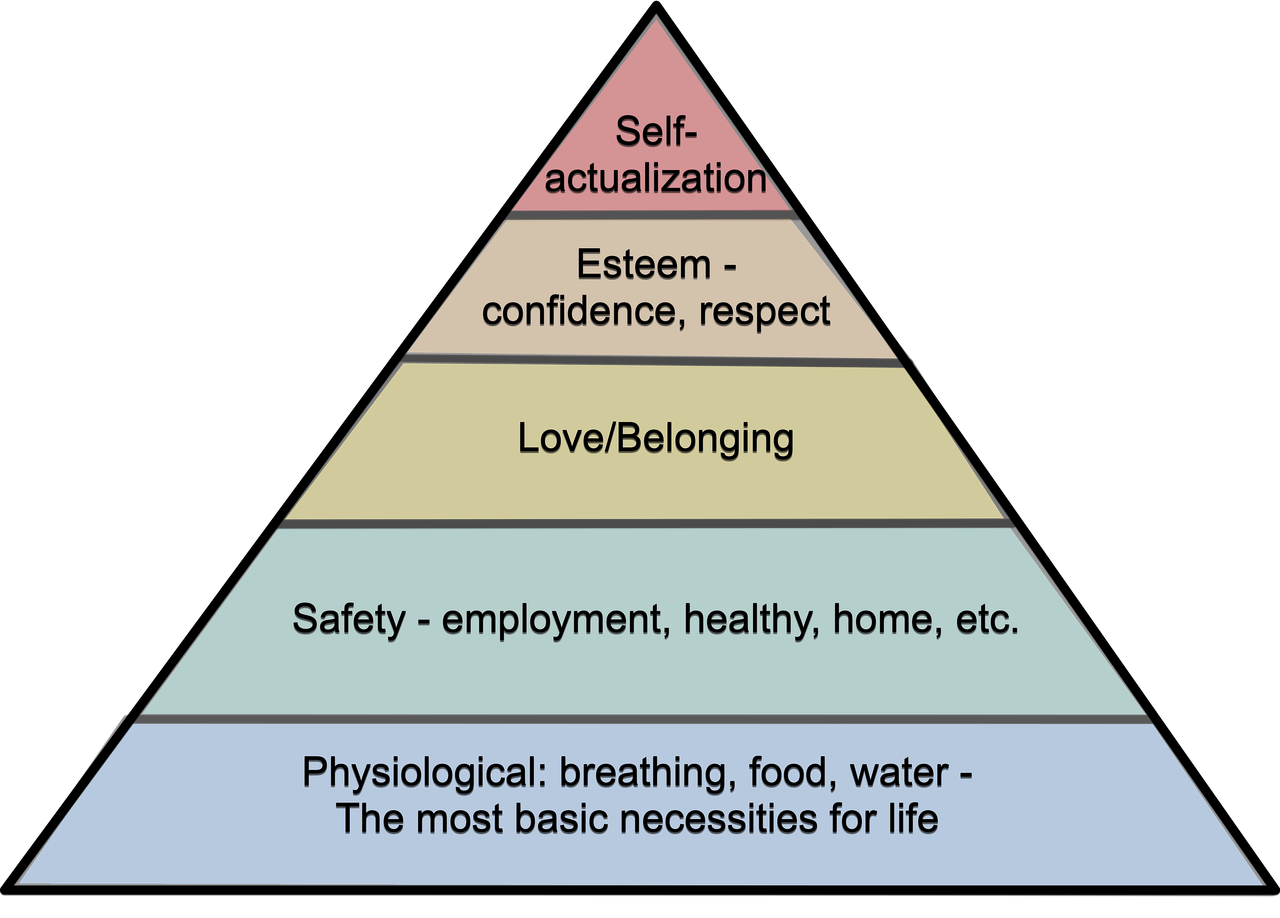Introduction
How do you motivate adults to learn in the corporate classroom? One answer lies in understanding what drives people, not just at work but also in their broader daily lives 🌍. One of the most enduring psychological theories that helps explain what drives human behavior is Abraham Maslow’s Hierarchy of Needs 🧠. First introduced in the 1940s, this theory has been pivotal in understanding human motivation and what makes people tick, and it’s still highly applicable today 📊.
In this blog post, we will explore the history of Maslow’s theory through a modern and relatable lens and, most importantly, offer suggestions on how corporate trainers can leverage this understanding to create more impactful training sessions. Let’s dive in! 🚀
History of Maslow’s Hierarchy of Needs
The story of Maslow’s theory begins with the man himself, Abraham Maslow. Maslow was an American psychologist who published a paper titled “A Theory of Human Motivation,” in 1943. In this paper, he introduced what would later become one of the most utilized models in psychology: the Hierarchy of Needs 📈. His model suggested that humans have a set of needs that must be met in a certain order, starting from the most basic physiological needs to the highest level of self-actualization 🌟.
The hierarchy is often represented as a pyramid with five levels, starting from Physiological Needs at the base, followed by Safety Needs, Love and Belonging ❤️, Esteem, and finally reaching Self-Actualization at the top. According to Maslow, individuals must satisfy lower-level needs before they can address higher-level needs. For example, it’s difficult for someone to focus on personal growth if they’re struggling to put food on the table 🍽️.
Maslow’s Hierarchy of Needs has since found its way into many aspects of society, including the workplace 💼. Understanding where your learners are on this hierarchy can help corporate trainers design training programs that resonate with learners and effectively meet their motivations.

The Five Levels of Maslow’s Hierarchy of Needs Explained
To fully grasp Maslow’s model, let’s unpack each of the different needs and illustrate how they manifest in real life 🎥.
1️⃣ Physiological Needs
This need forms the base of Maslow’s pyramid and consists of the fundamental requirements for human survival, such as food, water, sleep, and shelter 🛌. The movie Cast Away, starring Tom Hanks, provides a vivid representation of physiological needs. Chuck Noland, played by Tom Hanks, finds himself stranded on an uninhabited island, and his first instinct is to find food, water, and shelter. Everything else, including his job and relationships, takes a backseat until he is able to meet these basic needs.
In a corporate learning environment, it’s essential to recognize these physiological needs. It’s challenging for a learner to focus if they’re hungry, tired, or living out of their car 🚗. Which is something that front-line onboarding trainers will eventually run into. There are some easy things trainers can do, like making sure your learners are comfortable by providing snacks, coffee breaks ☕, and a well-maintained room. At other times, it’s best to let the learner know that you see them falling behind and ask if there is anything you might do to help. Sometimes, roadblocks to achieving physiological needs will be shared with you, and at that point, it’s best to involve HR. Your HR team is equipped with resources to enable the learner as best they can within the confines of the law.
2️⃣ Safety Needs
The next level of Maslow’s hierarchy is Safety Needs. These encompass both physical safety and emotional stability, such as job security, health, and a sense of protection 🛡️. In the movie A Quiet Place, the characters are constantly focused on avoiding dangerous monsters, and their entire lives revolve around safety. Their ability to focus on relationships or any higher goals is hindered until their immediate safety is assured.
In the workplace, job safety and fear of reprimand can be blockers for fostering an environment of growth 🌱. Employees who are worried about losing their jobs or feel that they are in an unsafe environment will not be able to focus on professional development. This does not mean that rules don’t apply to what you can say or do in the workplace, but rather that an environment that welcomes honest mistakes in the learning process should be promoted.
As corporate trainers, it’s important to respond to engagement with the materials in a way that positively reinforces participation while simultaneously correcting mistakes 👍. Make boundaries clear early with house rules and a deep dive into the employee handbook as needed. Reassure learners that what they are learning will help them achieve their professional aspirations and let them know that you don’t expect them to be perfect the first time 💡. Make sure that it is clear that this classroom is meant for experimentation and workshopping new skills.
3️⃣ Love and Belonging
The third level of the hierarchy is Love and Belonging. These needs revolve around relationships, friendships, family, and a sense of community 🤗. The sitcom Friends epitomizes this level. The show’s characters get immense support from each other, and their close bonds allow them to navigate life’s ups and downs. The sense of belonging they share serves as a critical source of emotional well-being.
When learners feel that they belong, they are more likely to be open, contribute, and learn from each other. In a corporate training setting, fostering a sense of community can help at many levels 👫. Starting with the broadest level, which includes everyone in training, then one step down, everyone you have trained, onto the class, then finally breakout groups within the class. Community can be created by setting up a buddy system, asking past trainees to share their experiences, or encouraging team competitions 🏆. It can be fostered by asking past trainees to come in and speak to your class about their journey through the training and the impact it now had on their current role. A sense of community can also be advanced in the class by giving them a name, setting class goals, and maintaining an open and positive atmosphere. Then finally, you can use breakouts for competitions, sharing of ideas, and feedback loops.
4️⃣ Esteem
Next comes Esteem, which includes both self-esteem and the respect of others. It’s about confidence, recognition, and feeling a sense of achievement 🎖️. Hermione is an excellent example of esteem through competence and recognition. In the Harry Potter series, she consistently proves herself to be intelligent and capable, whether in the classroom or during dangerous situations. Her value is eventually recognized by her friends and teachers, which builds her confidence and gives her a sense of pride.
In the corporate training environment, providing recognition and encouraging self-efficacy can meet learners’ esteem needs. Trainers should recognize achievements, acknowledge progress, and provide opportunities for learners to showcase their skills 💪. Whether through praise, certificates, or positive reinforcement, building learners’ confidence can improve their overall engagement.
5️⃣ Self-Actualization
Finally, at the top of the pyramid is Self-Actualization, which is the realization of one’s potential and the pursuit of personal growth 🌟. In Good Will Hunting, Will Hunting, played by Matt Damon, is a janitor with a genius-level IQ and a gift for mathematics. The story focuses on Will’s journey to recognize his own potential and overcome his fears to achieve self-actualization.
For corporate trainers, this level is about helping learners see beyond their current roles and envision their full potential ✨. Recognizing when learners are ahead of the curve and encouraging them to pursue stretch goals helps satisfy this need. Feedback loops with the employees’ leadership team can also help promote their skills and abilities and allow their leaders the opportunity to develop their top performers 🚀.
Applying Maslow’s Hierarchy in Corporate Training 💼📚
Understanding Maslow’s Hierarchy of Needs provides powerful insights into the motivations of adult learners. Below are some specific use cases for how corporate trainers can apply these principles to create more impactful learning experiences: ✨
Start with Comfort: Meeting Physiological and Safety Needs🛋️🛡️
No matter how well-designed a training program is, if learners’ basic needs aren’t met, engagement will be low. Before diving into content, corporate trainers should consider:
-
- Environment: Ensure that the physical environment is conducive to learning. This includes proper lighting, temperature, and seating. 💡🪑
- Breaks and Refreshments: Adults have a limited attention span. Providing breaks and refreshments (when possible) during long training sessions can help maintain focus. ☕🍎
- Psychological Safety: Establishing ground rules that promote respect and openness creates an environment where participants feel comfortable contributing.
Build Trust and Connection: Community in Training🤗🏢
A sense of belonging is crucial to adult learners. Trainers can foster this by:
-
- Icebreakers and Team Activities: Begin training sessions with icebreakers that allow participants to get to know each other. Team activities help establish a collaborative environment. Get creative with what constitutes the word “team” and think broader than the people sitting in your classroom. 🎉👥
- Open Dialogue: Encourage learners to share their experiences and provide insights. This sense of connection between participants builds belonging. 💬
Promote Confidence: Fulfilling Esteem Needs💪🌟
To effectively manage esteem needs, trainers can:
-
- Provide Positive Reinforcement: Celebrate progress, even small milestones. This can be done through verbal acknowledgment, certificates, or digital badges. 🏆🎖️
- Opportunities for Participation: Create opportunities for learners to share their expertise. Whether it’s through activities or contributing to discussions, these opportunities build confidence. 📢
Encourage Growth: Cultivating Self-Actualization🌱🚀
The ultimate goal of training is to help learners realize their potential. Trainers can do this by:
-
- Individual Learning Paths: Offer personalized learning opportunities that align with the outlier learner’s goals. Encourage them to explore subjects they are passionate about and support others if they are able. 📈🎯
- Stretch Assignments: Encourage learners to step out of their comfort zones with stretch assignments that challenge them to grow and develop new skills. 📊📋
- Share Feedback and Recommendations: Partner with high-performing learners’ management and encourage them to create a development plan. 📑🤝
The Role of Emotional Intelligence🧠💓
Emotional intelligence (EI) plays a crucial role in identifying and addressing the needs of learners. Trainers who are empathetic and attentive can better recognize whether a learner is feeling anxious, disengaged, or unsure of their value.
-
- Listen Actively: By actively listening to learners’ questions, concerns, and feedback, trainers can gauge their emotional state and identify any unmet needs. For example, if learners seem reluctant to participate, they may not feel a sense of belonging, and a team-building activity could be beneficial. 👂🗣️
- Body Language and Cues: Pay attention to non-verbal cues like body language and facial expressions. This can provide insight into whether learners are comfortable, feeling safe, or engaged. If someone appears visibly tense or withdrawn, they might need reassurance or a change in the training approach to feel more comfortable. 👀💭
- Empathy and Connection: Trainers who display empathy and seek to understand learners’ emotions can build stronger connections. This helps in meeting community needs and helps learners feel valued, which ultimately leads to more effective learning. 🫂💡
Maslow’s Hierarchy in Virtual Training Environments 💻🌐
With the rise of virtual and hybrid training environments, applying Maslow’s Hierarchy of Needs has taken on new dimensions. While many of the applications of the hierarchy of needs are the same, in a digital setting, addressing these needs may require some creativity. 🎨
- Physiological Needs: Ensure that learners have what they need to be successful online. Clear instructions, tech support, and an understanding of software and tools. Addressing potential issues such as poor internet connectivity upfront helps prevent physiological discomforts. 📶🖥️
- Love and Belonging: Virtual training can be isolating, so creating opportunities for learners to connect is critical. Use chat rooms, breakout groups, and icebreaker activities to foster a sense of community. Encourage learners to turn on cameras and participate actively to bridge the physical distance. 💬👥
- Esteem: Recognize achievements during live virtual sessions. Simple acknowledgments like calling out someone’s excellent response or displaying digital badges and reactions can help satisfy esteem needs. Create opportunities for learners to contribute to discussions and feel valued. 👍🏅
- Self-Actualization: Offer advanced resources that allow learners to continue exploring topics outside of the virtual classroom. Encourage them to join online communities or take on mentorship roles to facilitate personal growth. 📖👨🏫
Practical Training Exercises Using Maslow’s Theory 🎯💡
Here are some specific training exercises that corporate trainers can incorporate into sessions to leverage Maslow’s insights:
Safety and Psychological Safety Exercise
-
- Icebreaker Trust Exercise: Begin with an icebreaker that encourages vulnerability, such as sharing a positive work experience. This exercise helps create an emotionally safe environment. 🤗💬
Love and Belonging Activity
-
- Team Collaboration Project: Assign a team activity that is challenging yet rewarding. Groups can solve a problem or work on a creative project. The shared experience helps participants feel connected and part of something larger. 🛠️🤝
Esteem-Building Assignment
-
- Mini-Presentations: Ask learners to prepare a short presentation on a relevant topic. After each presentation, provide positive feedback as well as constructive feedback to build confidence and meet esteem needs. 📊👏
Self-Actualization Reflection
-
- Vision Board Activity: Have learners create a “vision board” of their professional goals. Ask them to think about where they see themselves in 5 years and what kind of skills they want to develop. This helps align training with their personal growth aspirations. 📋✨
Conclusion: Maslow’s Hierarchy as a Tool for Trainers 🏆📘
Maslow’s Hierarchy of Needs offers a lens through which corporate trainers can view and understand their learners. By recognizing where each individual is on the hierarchy and providing targeted support to address those needs, trainers can create an environment that is conducive to both learning and personal growth. 🌟🧠
In a corporate training setting, meeting physiological and safety needs might be as simple as providing comfortable facilities and a structured, respectful environment. Fostering love and belonging can be done through group exercises and encouraging connections. Esteem can be built by recognizing accomplishments and providing opportunities for individuals to contribute meaningfully. Finally, trainers can facilitate self-actualization by helping learners set and work toward personal growth goals. 🌱🏢
By keeping Maslow’s principles in mind and applying them in the training room, be it physical or virtual, corporate trainers can inspire their learners to grow, not only as professionals but also as individuals striving for their highest potential. 🚀👨🎓👩🎓
When you’re ready, here are some ways I can help:
Corporate Trainer Workshops
Need to upskill your team on a specific live or virtual training topic? I’ll work with you to identify the needs of your team and facilitate a hands-on workshop where you need it, when you need it, how you need it.
Consultation and Coaching
Need advice on a training project, your development process, or leading a training team? How about landing your next facilitator job? I’ll consult with you and help you be successful.
Custom Instructor-Led Training Development
Transforming your learning objectives into engaging and effective instructor-led training. Virtual or live, from development to train-the-trainers, we have your training needs covered.




